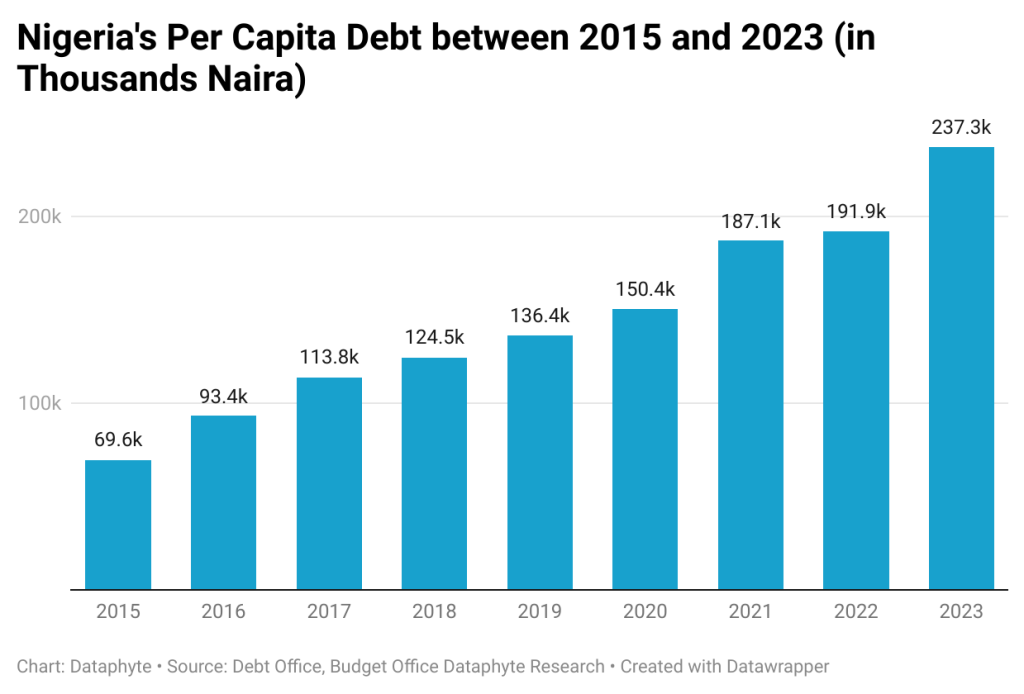Nigeria has solidified its position as one of the largest debtors to the World Bank’s International Development Association (IDA), with its debt exposure climbing to $17.1 billion as of September 30, 2024. This marks a $600 million increase from $16.5 billion in June 2024 and highlights the growing reliance on concessional financing to address the country’s fiscal challenges.
Nigeria’s Position Among Top IDA Borrowers
For the first time, Nigeria climbed into the top three IDA borrowers in June 2024, overtaking India to secure this position.
- Bangladesh: $21 billion
- Pakistan: $18.5 billion
- Nigeria: $17.1 billion
- India: $15.9 billion
- Ethiopia: $13.1 billion
Other notable borrowers include Kenya ($12.4 billion), Tanzania ($12.2 billion), and Vietnam ($12.2 billion). At the lower end, Ghana and Uganda owe $7 billion and $5 billion, respectively.
SEE ALSO: Dangote Refinery Dispute: A Threat to Nigeria’s Investment Climate
These ten countries together account for 63% of IDA’s total exposure, underscoring their dependency on concessional financing to address development challenges.
Nigeria’s Recent Borrowing Trend
Nigeria’s debt to the IDA grew substantially during the fiscal year ending June 2024.
- The country received an additional $2.2 billion in loans during the fiscal year.
- Under President Bola Tinubu’s administration, Nigeria has borrowed a total of $2.8 billion, with concessional financing serving as a cornerstone of the government’s funding strategy.
Understanding IDA Loans
IDA loans are highly concessional, offering low-interest rates and extended repayment periods, making them an attractive option for countries with limited fiscal space. These loans differ from financing provided by the International Bank for Reconstruction and Development (IBRD), which offers loans at market rates.
For Nigeria, IDA loans have been pivotal in managing inherited debts and funding critical development projects, particularly as the government implements reforms to stabilize the economy.
Debt Monitoring and IDA’s Single Borrower Limit (SBL)

IDA’s Single Borrower Limit (SBL) for FY2025 is set at $47.5 billion, representing 25% of its equity, which stood at $190.3 billion as of June 2024. Nigeria’s current debt exposure, though significant, remains well within this threshold.
According to IDA’s financial statements, “Monitoring these exposures relative to the SBL requires consideration of the repayment profiles of existing loans, as well as disbursement profiles and projected new loans and guarantees.”
Implications for Nigeria’s Economy
- Heavy Reliance on External Financing
- Nigeria’s position as the third-largest IDA borrower highlights its dependence on external funding to finance development projects and plug fiscal deficits.
- Fiscal Pressures
- The rising debt, coupled with currency depreciation, may strain Nigeria’s fiscal resources in the long term.
- Opportunities for Development
- Concessional loans provide Nigeria with a window to invest in infrastructure, healthcare, and economic reforms. If managed effectively, these investments could spur economic growth and reduce poverty.
Comparative Perspective
Nigeria’s exposure to IDA loans is significant but not unique. Other nations, like Bangladesh and Pakistan, also rely heavily on concessional financing. However, Nigeria’s economic trajectory and governance will determine whether these loans lead to sustainable growth or exacerbate fiscal challenges.
Strategic Recommendations for Nigeria
- Optimize Use of Borrowed Funds
- Ensure loans are directed toward high-impact projects that generate sustainable returns, particularly in sectors like energy, infrastructure, and technology.
- Strengthen Domestic Revenue Generation
- Broaden the tax base, improve tax collection efficiency, and diversify revenue streams to reduce dependence on external financing.
- Enhance Debt Management
- Develop comprehensive debt management strategies to balance concessional and market-rate loans while ensuring fiscal sustainability.
- Promote Transparency
- Increase transparency and public accountability in the utilization of borrowed funds to build trust and support among citizens.
Conclusion
Nigeria’s rising debt to the World Bank’s IDA reflects its ongoing fiscal challenges and the importance of external financing in its development agenda. While these loans provide critical support, ensuring they translate into tangible, sustainable economic gains will be essential. Effective debt management and strategic allocation of resources are crucial for navigating the fiscal landscape and fostering long-term growth.



